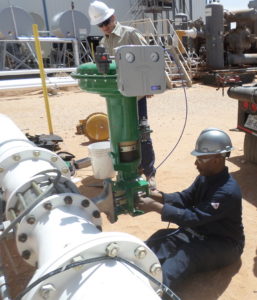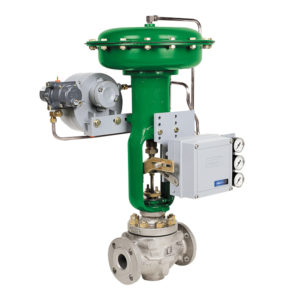 Process control is a lot like baking, says Jerry Butz, Director of Engineering and Technical Support here at Automation Service.
Process control is a lot like baking, says Jerry Butz, Director of Engineering and Technical Support here at Automation Service.
Baking requires specific quantities of ingredients and a steady supply of heat. To keep the oven at the desired temperature, your oven thermostat takes measurements and sends the data to a controller, which then turns the heating element on or off as required.
Recipes in the process industry specify variables like the level in a tank and the flow rate in a piping system. To keep those variables steady, a sensor takes measurements and sends the data to a controller, which then throttles a control valve as required.
As you can see from these examples, control systems work in three basic phases:
- Measure a variable (temperature, pressure, flow, etc.)
- Compare that measurement to the desired level (i.e., the setpoint)
- Adjust the system (e.g., open or close a valve) whenever there’s a discrepancy between the measured value and the setpoint
Read more about how controllers work here: Proportional Only vs Proportional + Reset Control
To achieve precise control, the speed and accuracy of all of these stages are important. Here, we’ll dig into how you can boost the speed and accuracy of the last phase — opening or closing a control valve to bring the measured value back to the setpoint.
What is a valve positioner?
In a standard system, the process controller sends a signal directly to the actuator, which moves the valve. This system works, but it can be slow, and actuators always have a certain offset, so they are only accurate within a range.
In applications where changes are made frequently or precision is required, something extra is needed to ensure fast, accurate responses. That something extra is a valve positioner.
A valve positioner is a device that interfaces with the process controller and the actuator, and is connected to the valve stem so it can sense the exact position of the valve. The positioner receives an input signal from the process controller and outputs a signal to the actuator to move the valve.
Read more about how valve positioners work here: Control Valve Actuator Bench Set Requirements
5 top benefits of valve positioners for control valves
Not all applications require valve positioners. But in many applications, valve positioners offer advantages, especially in systems where fluctuations can be disastrous for productivity or quality.
- More accurate control. Since valve positioners know the valve’s exact position, they provide more precise control than can be achieved by an actuator on its own. In addition, positioners improve accuracy in the lower part of the valve stroke, where errors are more common.
- Faster control. Positioners help control valves respond faster to changes in the process variable, minimizing the amount of time the system is operating above or below the setpoint.
- Consistent valve position, even with varying pressures. Varying differential pressure across the valve can indicate instability in the control loop. A positioner is one solution to help stabilize valve position.
- More flexible configurations and functions. A positioner allows you to put distance between the controller and the control valve, as well as to use diaphragm or piston-controlled actuators. You can also switch between direct and reverse control action or change the flow characteristics when necessary. You can even use one controller for two valves (i.e., split ranging).
- Minimal effects of friction, which causes hysteresis and deadband. Friction in the valve stem packing contributes to both hysteresis and deadband, which reduce productivity.
These aren’t the only benefits of positioners — the value you can gain from them depends on your application and the configuration of your system. To learn how installing positioners helped one oil company keep their system running at peak performance, check out our recent case study: How Trinity EOR Reduced Unplanned Downtime and Improved Plant Performance.
Sources:

